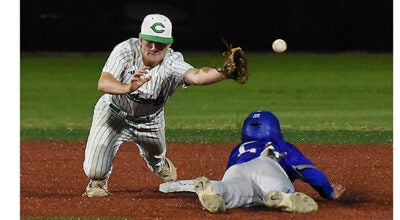New bats make game a little bit safer
Published 12:01 am Sunday, March 11, 2012
Change is always a difficult pill to swallow — or in this case, a difficult pitch to hit.
Well, more difficult to hit it over the wall, anyway. With the new rule from the National Federation of State High School Associations that all bats must be BBCor-approved, offensive production is likely to suffer.
Since the new bats are causing balls to come off the bat slower and not travel as far, some local high school players are adverse to the change.
College baseball teams were required to use BBCor bats starting in 2011, and offensive production went down. According to a Sept. 16, article by Brian Cartwright of the Hardball Times website, home runs were down 43 percent from the previous year, as were base hits per balls in play.
Area coaches and players say the change was made in the high school ranks because the NFHS wanted to create an environment that was safer for the athletes and coaches involved. With the ball not coming off the bat as quickly, the feeling is that there’s less of a chance for a pitcher to get hit in the face with a line drive. There’s also more time to react in case a foul ball comes flying into the dugout, right at someone’s face.
The reason seems justifiable. I’m sure any pitcher would be grateful to have less of a chance for a batted ball to cause serious injury and threaten his baseball career, not to mention his life. And just to highlight the dangers of a batted ball, Luis Salazar, a minor-league manager for the Atlanta Braves, lost an eye during spring training last year when a Brian McCann foul ball hit him in the face.
But no matter how many precautions are taken, no player or coach is ever truly “safe.” The new bats don’t completely eliminate the possibility of a batted ball heading in the direction of a human being. Once the ball leaves the bat, it’s impossible to control the ball’s trajectory. That’s why coaches always tell their players to be alert at all times.
Major League Baseball teams have in recent years come up with systems to control the development of their organizations’ pitchers by limiting the number of innings a player throws each season. The idea is that by gradually building their innings count up, instead of just making them throw 200 innings right away, it reduces the risk of arm injury.
I would certainly support any team trying to protect its assets as much as possible, but the truth of the matter is, if you want to protect a pitcher’s arm, make him stop pitching. Overhand is an unnatural motion, and when you’re throwing 100-plus pitches a game, it’s going to eventually take its toll.
There’s at least some similarity to innings limits as there are to the new BBCor bats. The idea behind both is logically sound, but the reality is that every action taken in baseball, whether it’s pitching or hitting, always carries some risk.
Compare the new bats rule with the rule on “hard hits” that are currently illegal in the NFL. Obviously, there’s a much greater injury risk with football as there is baseball, but depending on the sport, fans want to see one thing: hard hits in football and home runs in baseball.
While the new bats might make play safer, there’s always going to be that fan that feels like they’re being robbed of one of the main reasons to watch. For those that like small ball or pitching duels, however, the new bats might just be a belated Christmas present.
Michael Kerekes is the sports editor of The Natchez Democrat. He can be reached at 601-445-3632 or michael.kerekes@natchezdemocrat.com.





